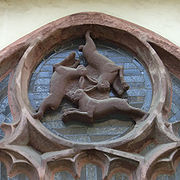
Paderborn Cathedral
Encyclopedia

Cathedral
A cathedral is a Christian church that contains the seat of a bishop...
of the Catholic Archdiocese of Paderborn. It is located in the city centre of Paderborn
Paderborn
Paderborn is a city in North Rhine-Westphalia, Germany, capital of the Paderborn district. The name of the city derives from the river Pader, which originates in more than 200 springs near Paderborn Cathedral, where St. Liborius is buried.-History:...
, North Rhine-Westphalia
North Rhine-Westphalia
North Rhine-Westphalia is the most populous state of Germany, with four of the country's ten largest cities. The state was formed in 1946 as a merger of the northern Rhineland and Westphalia, both formerly part of Prussia. Its capital is Düsseldorf. The state is currently run by a coalition of the...
, Germany
Germany
Germany , officially the Federal Republic of Germany , is a federal parliamentary republic in Europe. The country consists of 16 states while the capital and largest city is Berlin. Germany covers an area of 357,021 km2 and has a largely temperate seasonal climate...
. The cathedral is dedicated to Saint Mary
Mary (mother of Jesus)
Mary , commonly referred to as "Saint Mary", "Mother Mary", the "Virgin Mary", the "Blessed Virgin Mary", or "Mary, Mother of God", was a Jewish woman of Nazareth in Galilee...
, Saint Kilian
Saint Kilian
Saint Kilian, also spelled Killian , was an Irish missionary bishop and the apostle of Franconia , where he began his labours towards the end of the 7th century.-Background:...
and Saint Liborius
Saint Liborius
Liborius of Le Mans was the second Bishop of Le Mans. He is the patron saint of the cathedral and archdiocese of Paderborn in Germany. The year of his birth is unknown; he died in 397, reputedly on 23 July.-Le Mans and Paderborn:...
.
Architecture and history
The building is a hall churchHall church
A hall church is a church with nave and side aisles of approximately equal height, often united under a single immense roof. The term was first coined in the mid-19th century by the pioneering German art historian Wilhelm Lübke....
(i.e. with three aisles all reaching to the height of the roof) in a transitional Romanesque-Gothic style. The cathedral is mainly of the 13th century. The western tower of the 12th century is 93 m high. The relics of Saint Liborius are kept in the crypt
Crypt
In architecture, a crypt is a stone chamber or vault beneath the floor of a burial vault possibly containing sarcophagi, coffins or relics....
, which is with a length of 32 m one of Germany's largest crypts.
Points of especial interest
- Paradise Portal (before 1240)
- PietàPietàThe Pietà is a subject in Christian art depicting the Virgin Mary cradling the dead body of Jesus, most often found in sculpture. As such, it is a particular form of the Lamentation of Christ, a scene from the Passion of Christ found in cycles of the Life of Christ...
(around 1380) - GothicGothic artGothic art was a Medieval art movement that developed in France out of Romanesque art in the mid-12th century, led by the concurrent development of Gothic architecture. It spread to all of Western Europe, but took over art more completely north of the Alps, never quite effacing more classical...
high altar (late 15th century) - Double Madonna (around 1480)
- Tomb of Prince-Bishop Dietrich IV von Fürstenberg (d. 1618)
- PulpitPulpitPulpit is a speakers' stand in a church. In many Christian churches, there are two speakers' stands at the front of the church. Typically, the one on the left is called the pulpit...
in RégenceRégenceThe Régence is the period in French history between 1715 and 1723, when King Louis XV was a minor and the land was governed by a Regent, Philippe d'Orléans, the nephew of Louis XIV of France....
style (1736)
Window of Three Hares (Dreihasenfenster)

Three hares
The three hares is a circular motif appearing in sacred sites from the Middle and Far East to the churches of southwest England , and historical synagogues in Europe....
in motion, arranged in a triangle. Each hare is shown as having two ears, although only three ears are visible in total. The original 16th century carving can be found in the cloister
Cloister
A cloister is a rectangular open space surrounded by covered walks or open galleries, with open arcades on the inner side, running along the walls of buildings and forming a quadrangle or garth...
's inner courtyard, and has been duplicated on numerous buildings and a number of shops throughout the city centre.
Sources
- Virtual tour of Paderborn Cathedral
- Paderborn City website: Cathedral
- Paderborn City website: Eine „Hasengeschichte“ [Story of the Hares ] (PDF; 42 kB)
- Photos of the cathedral 2009
- Church service regulation
Further reading
- Bauer, Heinz, and Hohmann, Friedrich Gerhard, 1987 (1968): Der Dom zu Paderborn. Bonifatius-Druckerei, Paderborn, 4th revised edition 1987, 1st edition 1968. ISBN 3870885297.
- Lobbedey, Uwe, 1984: Der Dom zu Paderborn (Westfälische Kunststätten, Heft 33). Bonifatius-Druckerei, Paderborn 1984. ISBN 3870884231.
- Lobbedey, Uwe, 1990: Der Paderborner Dom (Westfälische Kunst). München/Berlin 1990
- Niggemeyer, Margarete, 1996: Bilder und Botschaften – Der Dom zu Paderborn als Sehschule des Glaubens. Paderborn: Bonifatius-Druckerei. ISBN 3870888814.

